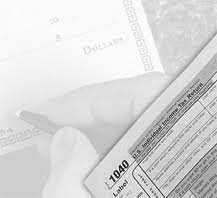CARL WATTS & ASSOCIATES
February 14th, 2011

|
Washington DC
|
tel/fax 202 350-9002 |
|
Standard deductions or itemized deductions?
If you are among taxpayers who have a choice, then you should obviously use the method that gives you the lowest tax.

If the money you paid for medical care, mortgage interest, taxes, charitable contributions, casualty losses and miscellaneous deductions is more than your standard deduction, you can benefit by itemizing.
|
||
|
The standard deductions for 2010 are: $5,700 for singles, $11,400 if married filing jointly, and $8,300 for head of household.
|
||
|
You cannot use the standard deduction if:
|
||
|
||
|
||
|
||
|
Standard deductions are not an option for estate or trust funds and partnerships as well.
|
||
|
What items are included on Schedule A?
|
||
|
To itemize your deductions you need to use Form 1040 Schedule A, which practically walks you through the whole itemizing process.
|
||
|
Medical and dental expenses may be deducted only for the amount which exceeds 7.5% of your AGI (adjusted gross income).
|
||
|
You may include in your medical expenses: insurance premiums paid for medical care or qualified long-term care insurance, fees paid to doctors and dentists, hospital services, treatments, drugs that require a prescription (except for insulin), false teeth, eyeglasses, hearing aids, transportation costs and so on. You can find extensive lists of deductible medical expenses online.
|
||
|
Your total medical expenses for the year must be reduced by any reimbursements you received personally or that was paid directly to the doctor or hospital.
|
||
|
Deductible taxes are mostly state and local taxes on income, real estate and personal property, but also foreign income and real estate taxes and qualified motor vehicle taxes.
|
||
|
Qualified residence interest and points (generally reported to you on Form 1098) include interest you pay for a loan secured with your main home or a second home.
|
||
|
You may also deduct investment interest (limited to your net investment income) but you cannot deduct personal interest (like interest paid on a loan to purchase a car or credit card or installment interest incurred for personal expenses).
|
||
|
Student loan interest is deducted separately, not on Schedule A.
|
||
|
You may also deduct charitable contributions made to qualified organizations.
|
||
|
We dedicated an entire newsletter to charitable contributions, so please use the link for details.
|
||
|
Casualty and theft losses may also be deducted to the extent that they exceed 10% of your AGI and $100 ($500 in 2009) per event.
|
||
| You may deduct gambling losses to the extent of your gambling income. |
Itemized Deductions
|
A wide range of miscellaneous expenses are also deductible on Schedule A, but only to the extent that they exceed 2% of your AGI. Because of this 2% floor, it is important to distinguish miscellaneous itemized deductions from other itemized deductions.
|
||||||||||||||
|
Miscellaneous itemized deductions may include:
|
||||||||||||||
|
||||||||||||||
|
||||||||||||||
|
||||||||||||||
|
||||||||||||||
|
||||||||||||||
|
If your AGI happens to be above a certain threshold (or applicable amount), then your total allowable itemized deductions will be reduced by 1/3 of the lesser of:
|
||||||||||||||
|
||||||||||||||
|
||||||||||||||
|
Itemized deductions which are subject to the limitation are: taxes, interest, charitable donations, job-related expenses and some miscellaneous deductions.
|
||||||||||||||
|
The limitation of itemized deductions is being “phased out” , meaning the total deduction is itself subject to a deduction. For years 2008 and 2009 the amount was reduced to 1/3 of the limitation.
|
||||||||||||||
|
NEW: For year 2010 taxpayers with AGI above a certain amount will no longer lose part of their itemized deductions.
|
||||||||||||||
|
If the amounts of your itemized deductions and the standard deduction don’t differ much, it might be better to chose the standard deduction to reduce the possibility of adjustment by the IRS and to keep your tax return less complicated.
|
||||||||||||||